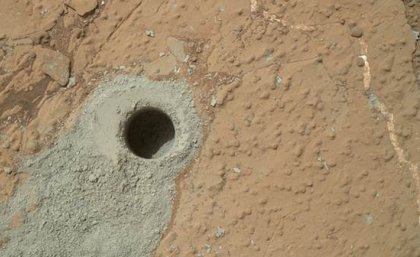
A UQ scientist has joined international colleagues to accurately date Martian rocks using a specially-designed instrument on board NASA’s Curiosity rover.
The remarkable finding is part of a series of ground-breaking discoveries made by UQ’s School of Earth Sciences Head Professor Paulo Vasconcelos and other members of the Curiosity rover team, published in six papers in the prestigious Science journal this week.
The team adapted specialised geochronological techniques used on Earth to determining the age and exposure history of rocks.
Professor Vasconcelos said the significance from a geological perspective was that the more recent the exposure, the more likely that an area could potentially be hosting signs of life.
“We can now use geochronology to guide where to look for signs of life en route to Mt Sharp, the ultimate goal of the Curiosity mission on Mars.”
The Martian rock – nicknamed “Cumberland” – was studied directly from a modified instrument aboard the Curiosity rover.
“We used a noble gas dating technique – the K-Ar dating method – to determine the age of the rock on Mars,” Professor Vasconcelos said.
“We then used the concentrations of three noble gas isotopes 3He, 21Ne, and 36Ar produced by cosmic rays at the Martian surface to determine how long the sample had been exposed on the surface of Mars.”
Analyses of data unveiled that the estimated age of the Cumberland rock was between 3.86 billion to 4.56 billion years, and that it had been exposed to the Martian surface for 60 million to 100 million years.
“Sixty to 100 million years of exposure for the sample is very recent for that site, suggesting that active geological processes have removed the shielding layers above the rock in the recent past,” Professor Vasconcelos said.
In a collaborative effort arising from a successful 2005 Australian Research Council grant, Professor Vasconcelos and Professor Ken Farley of Caltech (USA) had combined methodologies for simultaneously dating rocks and measuring their exposure ages while working on several Australian and Brazilian sites.
“To measure noble gas isotopes for geochronology on Earth, we had used large high-resolution sector mass spectrometers,” Professor Vasconcelos said.
“To make the same measurements on Mars as we did on Earth, we had to adapt and use a miniaturised quadrupole mass spectrometer – that was a big challenge.”
Media: UQ Faculty of Science Engagement Manager Julie Baglot, +61 7 411 162 577, j.baglot@uq.edu.au or Communications and Marketing Officer Aarti Kapoor, +61 0449 863 208, a.kapoor@uq.edu.au.
.jpg)

